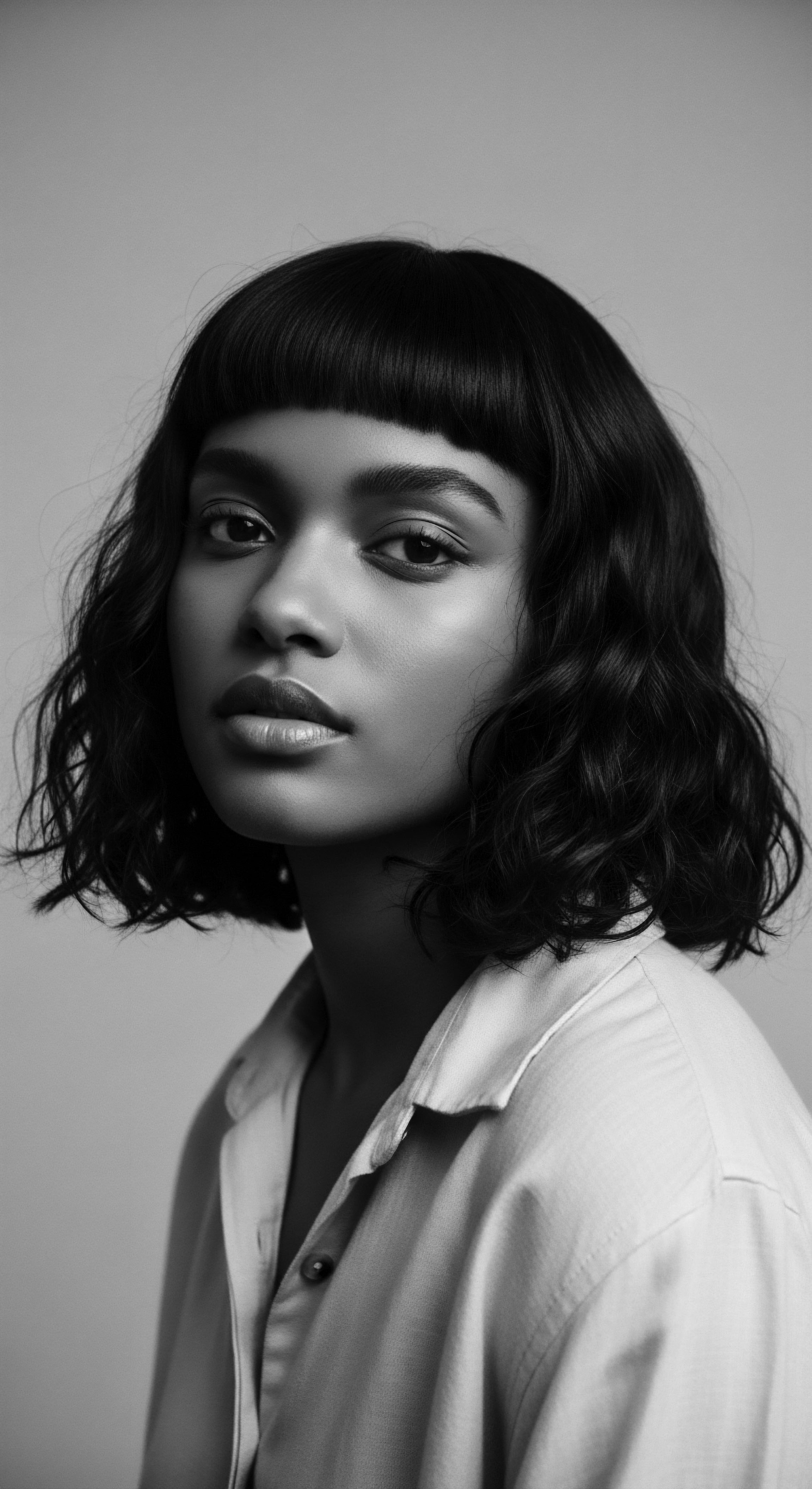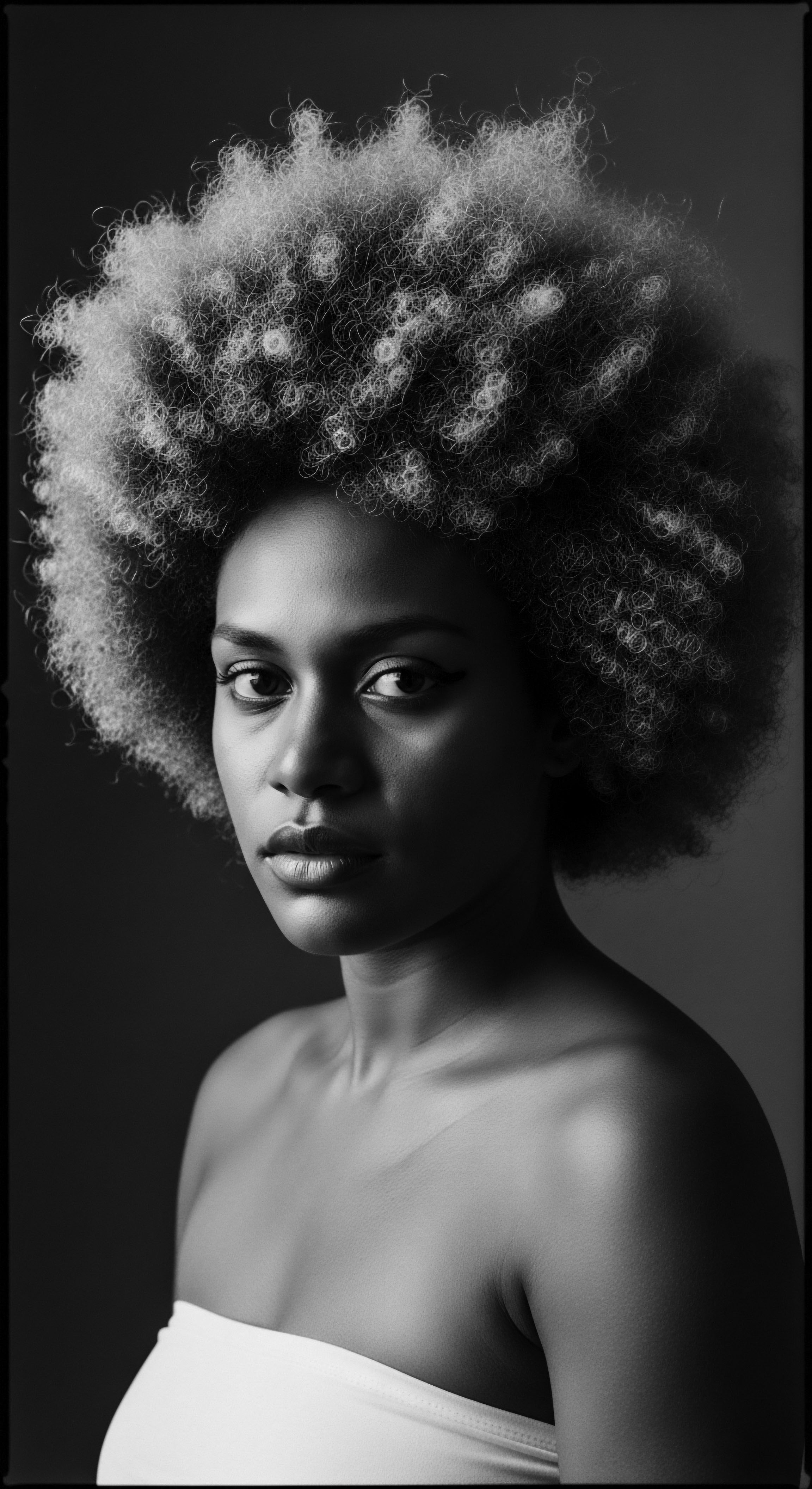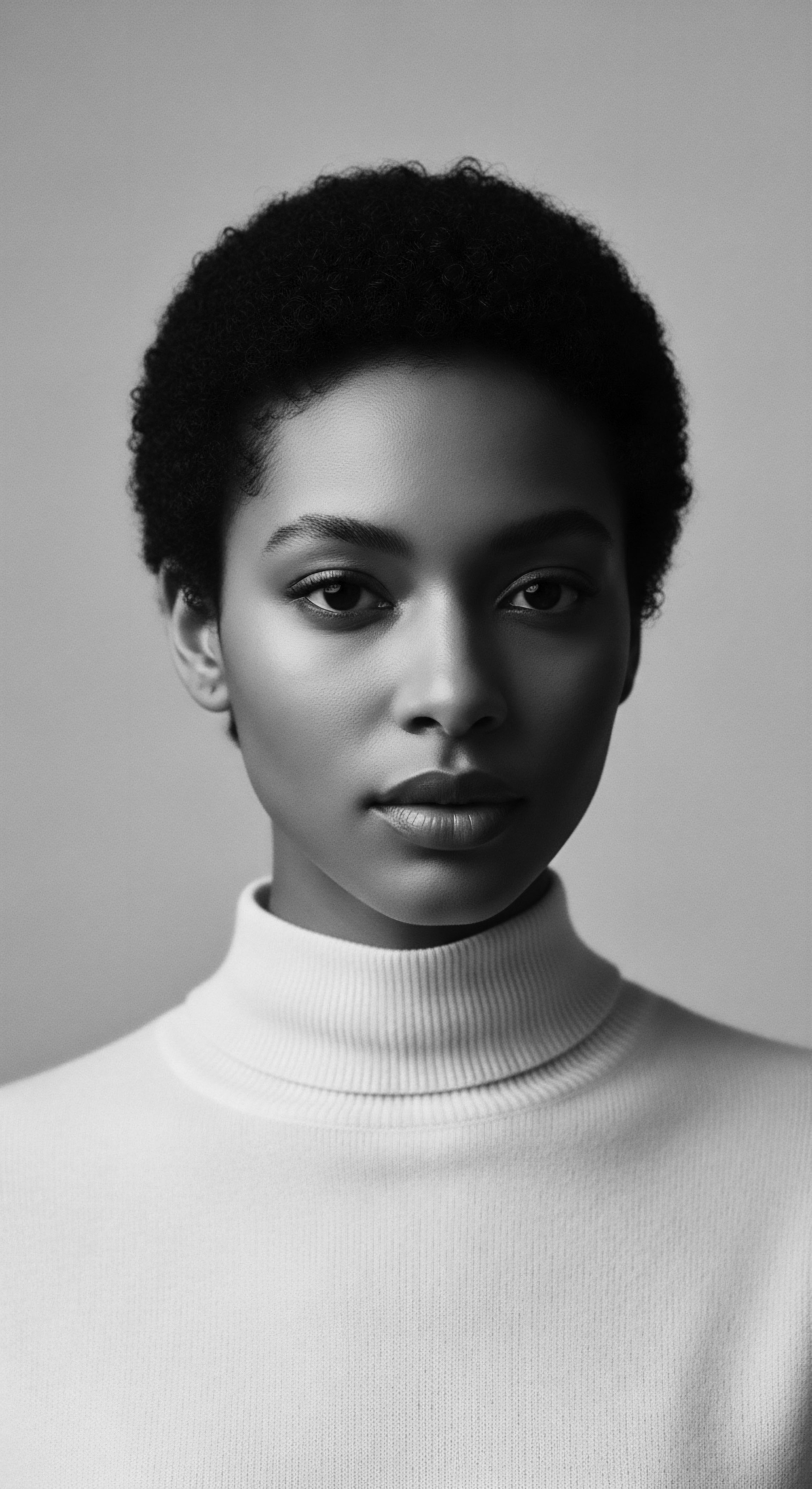
Fundamentals
The core substance of hair, its very being, can be understood through the lens of Keratin Function. This refers to the intricate processes by which keratin proteins, the primary constituents of hair, form, arrange themselves, and contribute to the overall physical and chemical characteristics of a hair strand. It is a biological explanation, a fundamental description, of how hair possesses its unique qualities—its strength, its elasticity, its inherent shape.
This understanding provides the base for appreciating why hair, particularly textured hair, holds such resilience. From the earliest moments of cellular formation within the scalp, keratin’s creation and its assembly dictate what the hair will become, a testament to the wisdom held within our genetic blueprint.
For communities with deeply rooted traditions of hair care, the meaning of keratin function has been intuitively grasped for generations, even without formal scientific terms. Ancestral wisdom recognized that certain plants, oils, and gentle manipulations preserved the hair’s vitality, protecting its very integrity. These practices, passed down through the ages, demonstrate a profound, lived understanding of how to maintain the hair’s structural components. It is a testament to observing, learning, and sharing knowledge about what sustains the hair fiber, preserving its essence against the elements and daily life.

The Building Blocks of Strength
Keratin itself is a fibrous structural protein, a kind of protective shield that builds hair, skin, and nails across the animal kingdom. In the context of hair, it exists as long, filamentous chains. These chains coil together, forming larger structures that ultimately create the hair shaft.
This fundamental arrangement, a kind of internal scaffolding, provides the fiber its inherent mechanical properties. Each segment, each connection, contributes to the strand’s ability to withstand stretching, bending, and the daily rigors of styling.
Understanding the keratin function begins with appreciating the smallest components. These are the amino acids, the individual molecular units that link together to build the keratin proteins. The specific sequence and type of these amino acids, particularly cysteine, are critical.
Cysteine contains sulfur atoms that form strong chemical connections, known as Disulfide Bonds. These bonds act like sturdy bridges between the protein chains, providing significant stability and contributing to the hair’s shape and strength.
The fundamental biological actions of keratin, from its initial synthesis to its final arrangement, dictate the unique character and resilience of each hair strand.

Echoes from the Source ❉ Hair’s Earliest Protection
Consider the ancient origins of textured hair, an adaptation shaped by the African sun and environment. The tightly coiled structures found in Afro-textured hair provided evolutionary advantages, offering insulation for the scalp against intense ultraviolet radiation and helping to retain moisture in arid conditions. This intrinsic design speaks to keratin’s primal function ❉ protection. The tightly packed keratin fibers, arranged in their distinctive helical patterns, form a natural barrier.
This biological fact underpins centuries of hair care practices that have sought to preserve and enhance this protective quality. The understanding of keratin function, then, traces back to the very survival of ancestral peoples, whose hair served as a vital shield.

Intermediate
Advancing our understanding, the meaning of keratin function deepens beyond a simple protein description. It encompasses the dynamic interplay between keratin and other components within the hair fiber, shaping its unique properties and dictating its response to external forces. For textured hair, this biological architecture is particularly relevant, influencing everything from moisture retention to breakage susceptibility. The way these proteins assemble, guided by genetics, profoundly defines the hair’s identity.

Molecular Architecture and Curl Patterns
The structural arrangement of keratin proteins within the hair cortex—the innermost and thickest part of the hair strand—is directly linked to curl patterns. Hair follicles with a more flattened or elliptical shape generate hair with tighter curls, as the keratin fibers within are arranged more asymmetrically. Conversely, rounder follicles tend to produce straighter hair.
This cellular blueprint dictates how keratin proteins, specifically alpha-keratins, align into complex macrofibrils. The disulfide bonds, discussed earlier, play an even more significant role here, stabilizing these coiled structures and allowing for the unique three-dimensional shapes that characterize textured hair.
The intermediate explanation of keratin function highlights the critical role of these internal bonds. When hair is wet, water can temporarily disrupt weaker hydrogen bonds within the keratin structure, allowing the hair to stretch. Upon drying, these bonds reform, and the hair returns to its original curl pattern.
This mechanism speaks to the hair’s elasticity, a valuable property that has long been respected in traditional hair care. Maintaining the integrity of these protein structures is essential for elasticity, preventing brittle strands that might break under tension.
The complex interaction of keratin proteins and disulfide bonds within each strand shapes the hair’s unique texture, reflecting both biological design and ancestral adaptation.

Ancestral Knowledge of Hair Integrity
Generations ago, without microscopes or chemical analysis, ancestral communities understood that maintaining the hair’s structure required gentle care and natural ingredients. They observed that hair, when nurtured, resisted damage. The practices of oiling, conditioning with natural plant extracts, and protective styling served to safeguard the keratin network.
For example, traditional hair oiling with substances such as Coconut Oil, rich in specific fatty acids, was found to reduce protein loss from hair. This traditional knowledge aligned with the scientific realization that certain oils can penetrate the hair shaft, reinforcing the internal keratin structure and minimizing damage from environmental stressors or mechanical manipulation.
- Oils ❉ Natural oils, like shea butter and coconut oil, used in traditional African hair care, provided lubrication and protection to the hair shaft, lessening friction and minimizing breakage.
- Braiding Techniques ❉ The historical practice of intricate braiding and protective styles served to reduce daily manipulation, shielding the hair’s keratin from environmental stress and mechanical strain.
- Herbal Infusions ❉ Various plant-based concoctions were applied, often implicitly providing protein-rich compounds or moisture-retaining agents that supported the hair’s structural health.
This traditional wisdom shows a profound understanding of hair’s needs, echoing what modern science would later confirm about keratin’s importance. The selection of specific ingredients and methods, often passed through oral histories and demonstrations within families and communities, preserved the very fabric of hair. It ensured that the strands, through generations, remained vibrant and strong, allowing for elaborate styles that communicated identity and status.

Academic
The academic delineation of keratin function transcends basic descriptions, delving into its biochemical complexities and biomechanical implications, particularly for textured hair. This advanced interpretation considers keratin as an incredibly resilient biopolymer system, crucial for the mechanical stability and integrity of the hair fiber. Its meaning extends into the subtle molecular forces that dictate hair’s response to environmental factors, chemical treatments, and mechanical stress, all viewed through the distinct lens of diverse hair types, especially those with tight curl patterns. A comprehensive examination demands an appreciation for the intricate protein-protein interactions and the role of specialized cellular processes in the hair follicle.

Microstructural Composition and Mechanical Properties
Keratin, as the predominant protein in hair, is organized into two primary types ❉ the softer, amorphous matrix keratins and the more structured, filamentous keratins. These fibrous keratins, primarily Alpha-Keratins, arrange themselves into coiled-coil structures, which then aggregate to form intermediate filaments. These filaments are embedded within a non-filamentous, cysteine-rich matrix, creating a robust composite material.
This hierarchical organization, extending from individual polypeptide chains to macrofibrils, is instrumental in the hair’s remarkable tensile strength and elasticity. The disulfide bonds formed between cysteine residues within these protein structures provide covalent cross-links, conferring chemical stability and contributing significantly to the hair’s mechanical properties, including its ability to resist deformation and breakage.
Textured hair, with its unique elliptical cross-sectional shape and varying distribution of cortical cells, possesses a distinctive keratin organization that impacts its biomechanical responses. The tighter the curl pattern, the more elliptical the hair shaft, which results in more points of stress along the curl’s curve, making it potentially more vulnerable to mechanical damage. This distinct morphology influences how hydration occurs and how quickly moisture is lost, directly affecting the keratin network’s plasticity and overall health. Dryness, a common concern for textured hair, can compromise the keratin matrix, leading to increased friction and potential breakage.

Case Study ❉ Hair as a Map and Life Source During Enslavement
A powerful historical example illuminates the intrinsic connection between keratin’s function, ancestral practices, and the profound resilience of textured hair ❉ the concealed knowledge within braided hairstyles during the transatlantic slave trade. Enslaved African women, forcibly removed from their homelands, carried invaluable sustenance and cartographic information within their meticulously braided hair. This practice relied directly on the hair’s structural integrity, a function of its keratin composition and the skilled hands that manipulated it. In preparation for their perilous journeys aboard slave ships, kidnapped African women secreted Rice Grains and other seeds within their intricate braids.
This allowed them to carry life-sustaining resources to unfamiliar lands. Once on the other side of the Atlantic, these hidden seeds, protected within the strong keratin matrix of their hair, could be planted in subsistence gardens.
The survival of these seeds, capable of sprouting new life in harsh environments, speaks to the hair’s ability to protect its contents. It indicates the remarkable durability and protective function afforded by the densely packed keratin, especially within complex braided styles like cornrows. These hairstyles were not merely decorative; they were profound acts of cultural preservation and survival. A specific narrative recounts that the Maroons of Suriname hid grains inside their braids to sustain themselves and their communities while fleeing into rainforests to escape their enslavers.
Some varieties of rice still bear the names of the women—such as Sééi, Sapali, and Tjowa—who carried them to freedom within their hair. This speaks to the hair’s dual capacity ❉ a biological structure providing physical protection, and a cultural medium for resistance and liberation. The capacity of keratin to maintain hair’s structural integrity under duress made these acts possible, highlighting a direct, visceral link between the hair’s biological function and the survival strategies of enslaved peoples.
| Ancestral Practice Oiling with Natural Fats (e.g. Shea Butter) |
| Connection to Keratin Function (Traditional Understanding) Provided hair with suppleness, sheen, and resistance to breaking, observed to make hair more "pliable" and "strong." |
| Scientific Elucidation (Modern Understanding) Lipids (fats) form a protective layer on the hair's surface, reducing cuticle damage and moisture loss, thereby preserving the keratin structure's flexibility. |
| Ancestral Practice Gentle Detangling with Wide-Tooth Combs |
| Connection to Keratin Function (Traditional Understanding) Minimized hair shedding and pain, recognizing the hair's delicate nature when wet or dry. |
| Scientific Elucidation (Modern Understanding) Reduces mechanical stress on the keratin network, preventing breakage of weaker disulfide bonds and external cuticle scales. |
| Ancestral Practice Protective Styling (e.g. Braids, Twists) |
| Connection to Keratin Function (Traditional Understanding) Kept hair contained, tidy, and protected from daily elements; seen as a way to "rest" the hair. |
| Scientific Elucidation (Modern Understanding) Minimizes external exposure to environmental stressors and reduces physical manipulation, thereby preserving the keratin's structural integrity and preventing mechanical wear. |
| Ancestral Practice Use of Plant Mucilages (e.g. Aloe Vera) |
| Connection to Keratin Function (Traditional Understanding) Provided hydration and slip, making hair easier to manage and less prone to tangling. |
| Scientific Elucidation (Modern Understanding) Polysaccharides and water-binding agents hydrate the hair, improving the flexibility of the keratin protein and reducing friction between strands. |
| Ancestral Practice These traditional methods, steeped in cultural significance, reveal a long-held intuitive wisdom about maintaining the vitality of hair's keratin structures, a legacy of adaptive care. |
The ongoing challenges faced by textured hair, such as hygral fatigue (damage from repeated swelling and shrinking with water exposure) and greater susceptibility to protein loss, are directly linked to the specific arrangement and density of disulfide bonds within its keratin structure. For instance, research indicates that compared to straight hair, the keratin protein packing in textured hair is less uniform, rendering strands more prone to breakage and split ends. This knowledge informs contemporary hair science, leading to the development of products that specifically target bond repair and protein-moisture balance to strengthen the keratin framework.
The academic interpretation of keratin function for textured hair also acknowledges the socio-historical implications. The devaluation of natural hair textures during colonial periods and the transatlantic slave trade led to practices that often compromised the hair’s keratin integrity, such as harsh chemical straightening. The resurgence of the natural hair movement is not only a cultural reclaiming but also a scientific re-education, fostering a collective understanding of how to properly care for and protect textured hair’s unique keratin structure, moving away from damaging practices and toward restorative ones.

Reflection on the Heritage of Keratin Function
The journey through the definition of keratin function, from its elemental biology to its deepest scientific expression, ultimately guides us back to the heart of heritage. The understanding of this vital protein is not simply a biological fact; it is a living archive, a narrative of resilience woven into every coil and curl. We perceive how the science of keratin echoes the ancestral wisdom that has sustained textured hair across generations and continents. The inherent strength and distinct patterns of Black and mixed-race hair are a direct testament to the remarkable capabilities of this protein, shaped by deep time and diverse environments.
This shared legacy of hair care, passed down through the hands of mothers, aunties, and community elders, reflects an intuitive grasp of what keratin needs to thrive. The ritual of wash day, the careful application of plant-derived oils, the deliberate art of braiding—these were not merely routines. They were acts of profound connection to the hair’s intrinsic nature, safeguarding its protein foundation long before terms like ‘disulfide bonds’ entered common discourse. These practices reveal a continuous conversation between human hands and the strands they tend, a dialogue rooted in respect for the hair’s natural inclinations and the wisdom of its biology.
The journey of understanding keratin function within textured hair is a profound dialogue between the language of biology and the enduring wisdom of ancestral care.
As we step forward, armed with scientific knowledge that affirms ancient truths, we carry a responsibility. It is a call to honor the inherent beauty of textured hair and to recognize its journey as a symbol of identity, survival, and boundless creativity. The future of textured hair care is one that harmonizes cutting-edge science with the tender, time-tested traditions of our forebears.
Each strand, in its glorious uniqueness, tells a story of survival, a story of resistance, and a story of beauty redefined on its own terms. The continued exploration of keratin function, therefore, is an act of reverence, contributing to a deeper appreciation for the living heritage that graces so many heads today.

References
- Rosado, S. D. (2007). Nappy Hair in the Diaspora ❉ Exploring the Cultural Politics of Hair Among Women of African Descent. University of Florida.
- Davis-Sivasothy, A. (2011). The Science of Black Hair ❉ A Comprehensive Guide to Textured Hair Care. SAJO Publishing.
- Oladele, D. Markiewicz, E. & Idowu, O. C. (2024). The Genomic Variation in Textured Hair ❉ Implications in Developing a Holistic Hair Care Routine. Preprints.
- Pergament, D. (1999). It’s Not Just Hair ❉ Historical and Cultural Considerations for an Emerging Technology. Chicago-Kent Law Review, 75(1).
- Lashley, M. (2014). The importance of hair in the identity of Black people. Nouvelles Pratiques Sociales, 27(2), 218–234.
- Tinoco, A. De Oliveira, A. L. De Oliveira, F. L. & Fernandes, A. M. (2018). Keratin-based particles for protection and restoration of hair properties. International Journal of Cosmetic Science, 40(3), 291-298.
- McMichael, A. J. & Johnson, D. (2009). Hair Care Practices in African-American Patients. Seminars in Cutaneous Medicine and Surgery, 28(2), 103-108.
- Peacock, T. N. (2019). African American Hair and Beauty ❉ Examining Afrocentricity and Identity Through the Reemergence and Expression of Natural Hair in the 21st Century (Master’s thesis). University of South Carolina.
